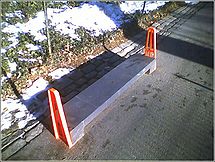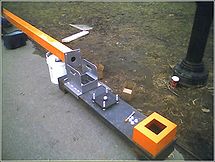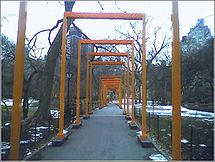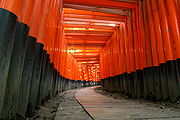
The Gates
Encyclopedia
The Gates was a site-specific
work of art by Christo and Jeanne-Claude
. The artists installed 7,503 vinyl "gates" along 23 miles (37 km) of pathways in Central Park
in New York City
. From each gate hung a panel of deep saffron-colored nylon
fabric. The exhibit ran from February 12, 2005 through February 27, 2005.
The books and other memorabilia distributed by Christo and Jeanne-Claude refer to the project as The Gates, Central Park, New York, 1979–2005 in reference to the time that passed from the artists' initial proposal until they were able to go ahead with it.
The Gates were greeted with mixed reactions. Some people loved them for brightening the bleak winter landscape; others hated them, accusing them of defacing the landscape. Some cyclists saw them as an obstruction which could cause accidents, although cycling is not legal on those paths. They received a great deal of their nationwide fame as a frequent object of ridicule by David Letterman
as well as Keith Olbermann
, whose apartment was nearby.
As one of the conditions for use of the park space, the steel bases rested upon, but remained unattached to, the walkways, so that no holes were drilled and no permanent changes were made to the park.
The artists sold pieces of their own artwork, including preparatory drawings for The Gates, to finance the project.
They offered a cost of $
21 million and the details are published in the Harvard Business School. Greg Allen
and The New York Times
attempted to itemize the costs and could account for about $
5–10 million, given reasonable estimates for parts, labor, and costs related to the staffing of the installation.
 On January 3, 2005, work began on the installation of the project.
On January 3, 2005, work began on the installation of the project.
During the week of January 17, the park filled with workers using forklift vehicles to move the rectangular steel plates into position all over Central Park.
There were small signs placed on every walkway in the park with alphanumeric codes which the workers used to place the metal plates onto the designated spots.
By January 27, most of the rectangular metal plates were positioned. All had small orange plastic markers sticking up two feet (around half a meter) from each end, possibly intended to help people find the base plates if they were covered with snow. A major snow storm on January 22 and extreme cold hampered progress.
 As of February 7, many teams of workers, wearing grey uniforms, moved the vertical parts of the gates, and attached them to the base plates. The documentation describes the color as saffron but many local observers described it as orange.
As of February 7, many teams of workers, wearing grey uniforms, moved the vertical parts of the gates, and attached them to the base plates. The documentation describes the color as saffron but many local observers described it as orange.
The attached vertical fabric pieces were 16 feet (4.877 m) high, with a crossbar at the top from which the flag pieces were unfurled. The most common width seems to have been 11 feet (3.35 m) although the width varied, depending on the width of the path, from 5 feet 6 inches to 18 feet.
 The rest of The Gates were opened subsequently throughout the park and were completed within the next few hours with large crowds of people watching. Generally, the crews of workers who erected the gates were assigned to open them. They walked underneath, and used a hook at the end of a long stick to pull a loop hanging from the crossbar of each gate. That opened the cloth bag containing the fabric panel part of the gate. The bag fell to the ground, along with a cardboard tube around which the fabric was rolled. The fabric part then hung from the horizontal crossbar.
The rest of The Gates were opened subsequently throughout the park and were completed within the next few hours with large crowds of people watching. Generally, the crews of workers who erected the gates were assigned to open them. They walked underneath, and used a hook at the end of a long stick to pull a loop hanging from the crossbar of each gate. That opened the cloth bag containing the fabric panel part of the gate. The bag fell to the ground, along with a cardboard tube around which the fabric was rolled. The fabric part then hung from the horizontal crossbar.
By the afternoon of February 12, all of the panels were unfurled.
The project staff remained deployed in the park, patrolling, and replacing damaged gates. One of the gates, near the Shakespeare Garden in front of the Delacorte Theatre, was vandalized and replaced frequently.
After the exhibition closed on February 27, the gates and bases were removed and the materials were industrially recycled.
gates, traditionally constructed at the entrance to Shinto
shrine
s. Thousands of vermilion
-colored torii line the paths of the Fushimi Inari shrine in Kyoto
, Japan
. Successful Japanese businessmen traditionally purchased a gate in gratitude to Inari, the god of worldly prosperity.
Site-specific art
Site-specific art is artwork created to exist in a certain place. Typically, the artist takes the location into account while planning and creating the artwork...
work of art by Christo and Jeanne-Claude
Christo and Jeanne-Claude
Christo and Jeanne-Claude were a married couple who created environmental works of art...
. The artists installed 7,503 vinyl "gates" along 23 miles (37 km) of pathways in Central Park
Central Park
Central Park is a public park in the center of Manhattan in New York City, United States. The park initially opened in 1857, on of city-owned land. In 1858, Frederick Law Olmsted and Calvert Vaux won a design competition to improve and expand the park with a plan they entitled the Greensward Plan...
in New York City
New York City
New York is the most populous city in the United States and the center of the New York Metropolitan Area, one of the most populous metropolitan areas in the world. New York exerts a significant impact upon global commerce, finance, media, art, fashion, research, technology, education, and...
. From each gate hung a panel of deep saffron-colored nylon
Nylon
Nylon is a generic designation for a family of synthetic polymers known generically as polyamides, first produced on February 28, 1935, by Wallace Carothers at DuPont's research facility at the DuPont Experimental Station...
fabric. The exhibit ran from February 12, 2005 through February 27, 2005.
The books and other memorabilia distributed by Christo and Jeanne-Claude refer to the project as The Gates, Central Park, New York, 1979–2005 in reference to the time that passed from the artists' initial proposal until they were able to go ahead with it.
The Gates were greeted with mixed reactions. Some people loved them for brightening the bleak winter landscape; others hated them, accusing them of defacing the landscape. Some cyclists saw them as an obstruction which could cause accidents, although cycling is not legal on those paths. They received a great deal of their nationwide fame as a frequent object of ridicule by David Letterman
David Letterman
David Michael Letterman is an American television host and comedian. He hosts the late night television talk show, Late Show with David Letterman, broadcast on CBS. Letterman has been a fixture on late night television since the 1982 debut of Late Night with David Letterman on NBC...
as well as Keith Olbermann
Keith Olbermann
Keith Theodore Olbermann is an American political commentator and writer. He has been the chief news officer of the Current TV network and the host of Current TV's weeknight political commentary program, Countdown with Keith Olbermann, since June 20, 2011...
, whose apartment was nearby.
Construction and cost
The total materials used according to the artists were 5,390 tons of steel, 315,491 feet (96 km) of vinyl tubing, 99,155 square metres of fabric, and 15,000 sets of brackets and hardware. The gates were assembled in a 25,000 square foot (2,300 m²) Long Island facility, then trucked to Central Park. The textile was produced and sewn in Germany.As one of the conditions for use of the park space, the steel bases rested upon, but remained unattached to, the walkways, so that no holes were drilled and no permanent changes were made to the park.
The artists sold pieces of their own artwork, including preparatory drawings for The Gates, to finance the project.
They offered a cost of $
United States dollar
The United States dollar , also referred to as the American dollar, is the official currency of the United States of America. It is divided into 100 smaller units called cents or pennies....
21 million and the details are published in the Harvard Business School. Greg Allen
Greg Allen
Greg Allen was an Australian rugby league player for the Cronulla-Sutherland Sharks in the New South Wales Rugby League competition...
and The New York Times
The New York Times
The New York Times is an American daily newspaper founded and continuously published in New York City since 1851. The New York Times has won 106 Pulitzer Prizes, the most of any news organization...
attempted to itemize the costs and could account for about $
United States dollar
The United States dollar , also referred to as the American dollar, is the official currency of the United States of America. It is divided into 100 smaller units called cents or pennies....
5–10 million, given reasonable estimates for parts, labor, and costs related to the staffing of the installation.
Installation

During the week of January 17, the park filled with workers using forklift vehicles to move the rectangular steel plates into position all over Central Park.
There were small signs placed on every walkway in the park with alphanumeric codes which the workers used to place the metal plates onto the designated spots.
By January 27, most of the rectangular metal plates were positioned. All had small orange plastic markers sticking up two feet (around half a meter) from each end, possibly intended to help people find the base plates if they were covered with snow. A major snow storm on January 22 and extreme cold hampered progress.

The attached vertical fabric pieces were 16 feet (4.877 m) high, with a crossbar at the top from which the flag pieces were unfurled. The most common width seems to have been 11 feet (3.35 m) although the width varied, depending on the width of the path, from 5 feet 6 inches to 18 feet.
Opening
The project was officially launched on February 12, 2005, when New York Mayor Michael R. Bloomberg dropped the first piece of fabric at 8:30 a.m., with Christo and Jeanne-Claude in attendance.
By the afternoon of February 12, all of the panels were unfurled.
The project staff remained deployed in the park, patrolling, and replacing damaged gates. One of the gates, near the Shakespeare Garden in front of the Delacorte Theatre, was vandalized and replaced frequently.
After the exhibition closed on February 27, the gates and bases were removed and the materials were industrially recycled.
Inspirations
The Gates alludes to the tradition of Japanese toriiTorii
A is a traditional Japanese gate most commonly found at the entrance of or within a Shinto shrine, where it symbolically marks the transition from the profane to the sacred...
gates, traditionally constructed at the entrance to Shinto
Shinto
or Shintoism, also kami-no-michi, is the indigenous spirituality of Japan and the Japanese people. It is a set of practices, to be carried out diligently, to establish a connection between present day Japan and its ancient past. Shinto practices were first recorded and codified in the written...
shrine
Shrine
A shrine is a holy or sacred place, which is dedicated to a specific deity, ancestor, hero, martyr, saint, daemon or similar figure of awe and respect, at which they are venerated or worshipped. Shrines often contain idols, relics, or other such objects associated with the figure being venerated....
s. Thousands of vermilion
Vermilion
Vermilion is an opaque orangish red pigment, similar to scarlet. As a naturally occurring mineral pigment, it is known as cinnabar, and was in use around the world before the Common Era began. Most naturally produced vermilion comes from cinnabar mined in China, and vermilion is nowadays commonly...
-colored torii line the paths of the Fushimi Inari shrine in Kyoto
Kyoto
is a city in the central part of the island of Honshū, Japan. It has a population close to 1.5 million. Formerly the imperial capital of Japan, it is now the capital of Kyoto Prefecture, as well as a major part of the Osaka-Kobe-Kyoto metropolitan area.-History:...
, Japan
Japan
Japan is an island nation in East Asia. Located in the Pacific Ocean, it lies to the east of the Sea of Japan, China, North Korea, South Korea and Russia, stretching from the Sea of Okhotsk in the north to the East China Sea and Taiwan in the south...
. Successful Japanese businessmen traditionally purchased a gate in gratitude to Inari, the god of worldly prosperity.
 |
 |
External links
- The Gates on the Christo and Jeanne Claude website
- Central Park's 'Gates' to close, a February 25, 2005 CNN story
- The Gates @ Central Park. A community blog on which anyone may post comments about The Gates via email or mobile phone.
- 'The Gates' Bill. Greg Allen, greg.org, February 13, 2005.
- http://vinestreetworks.com 8 minute film for download: 'A Walk Through the Gates'
- "Enough About 'Gates' as Art; Let's Talk About That Price Tag." The New York Times, March 5, 2005, investigates the $21 million claim.
- The Gates Photo Gallery
- The Somerville Gates, a parody
- In Pictures: The Gates - Extrageographic Magazine
- Geotagged photograph of The Gates - Panoramio
- Stephen Colbert describes The Gates
- Cave Paintings and Christo's "Gates": Art in Individual Minds and Public Places

